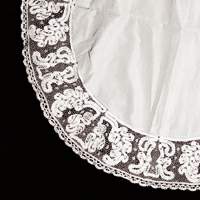Juraj Zajonc
Although the life’s work of Ema Marková (1902 – 1989) is connected to traditional materials, mainly textile culture and folk artistic production in specialist as well as amateur circles, her professional work started in a different arena altogether. In 1926 she completed studying law in Bratislava, one of the first women in Slovakia to undergo this type of education. In 1925, during her studies, she worked in the Business and Industrial Chamber, where she remained until 1947. While working at this institution, she was responsible for maintaining and developing domestic production. She was a member of the board of directors of the stock company Detva and this is where she familiarized herself with the state of domestic production and at the same time tried to create suitable conditions for its development. After the break-up of the Czechoslovak Republic in 1938, Ema Marková started to maintain fully all embroidery workshops within the Association for the Improvement of Domestic Production. She participated in its establishment in 1939, and was a director until 1953 at which time it ceased to exist. She provided new material: in the beginning she sold embroidery herself and she also enriched the variety of new patterns. During this period of time she developed the idea of transferring production of ceasing types of embroidery from agricultural villages to mining embroidery workshops. A further period of great organizational work from Ema Marková was the establishment of the Centre for Folk and Art Production (ÚĽUV) in 1945, in which she initiated and co-participated in creating the law establishing it. She worked there until 1959. She participated significantly in creating the overall concept for ÚĽUV: she defined its objectives and methods of implementation, including discovery and documentation activities. She was instrumental in reviving the already ceased or ceasing production of tapestry, splint baskets and Romany embroidery. Her contribution can also be seen in the enriched variety of pottery, carving and blue print products. Since the establishment of ÚĽUV, through her contribution, as documentation department was created for pictorial as well as written documents, publications and mainly artefacts obtained with research directly in the environment of their creation and use. The personality of Ema Marková joined the attitudes of emancipated women with a deep respect for tradition. Similarly, solid research with unrest of artistically creative person went hand in hand. She developed her artistic talent in the area of bobbin lace design. While showing respect for the basic patterns, she modified them to a certain extent or created new patterns, motif compositions and variations from them. In 1952 Jozef Vydra described the work of Ema Marková as a real artistic renaissance for Slovak embroidery. Ema Marková also paid attention to other textile techniques that were ceasing to exist in the first half of the twentieth century. She researched, for example, weaving on small machines, needle knitting, weaving on cards, historical pattern textiles and tapestry production. The fundamental monographic works by Ema Marková are Slovak Folk Textile (1956), Slovak Embroidery (1962) and Slovak Folk Materials (1976).
